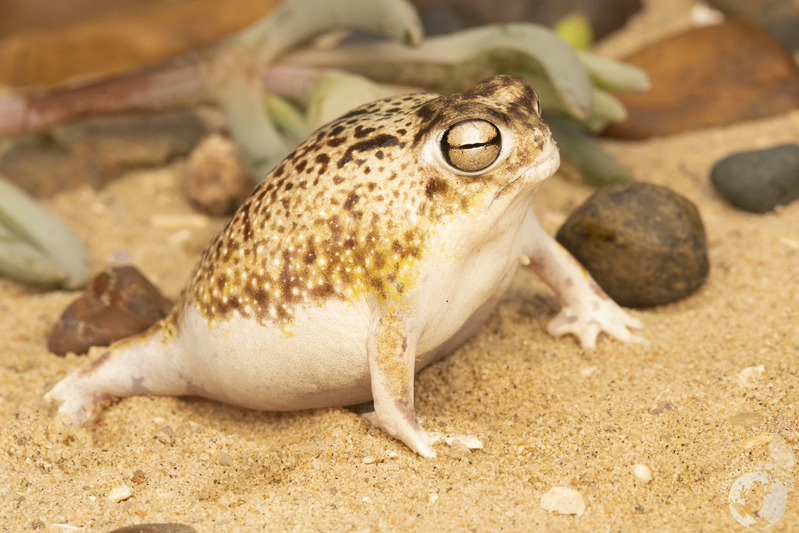The desert rain frog (Breviceps macrops) is one of the most fascinating amphibians found in the arid regions of southern Africa. Known for its distinctive appearance, peculiar vocalizations, and adaptation to harsh environments, the desert rain frog has captivated researchers and nature enthusiasts alike. This article explores the desert rain frog in detail, covering its habitat, physical characteristics, behaviors, and conservation status.

The desert rain frog belongs to the following classification:
Kingdom: Animalia
Phylum: Chordata
Class: Amphibia
Order: Anura
Family: Brevicipitidae
Genus: Breviceps
Species: Breviceps macrops
Body Shape:
The desert rain frog has a round, squat body with short limbs and a flat face.
Eyes:
It is characterized by large, bulging eyes that aid in nocturnal vision.
Size:
Measuring just 4–6 cm in length, this small amphibian is deceptively powerful for its size.
The desert rain frog is famous for its squeaky, high-pitched calls, often described as sounding like a squeaky toy. This unique vocalization is used for communication, especially during mating or territorial disputes.
The desert rain frog is endemic to the coastal deserts of Namibia and South Africa. Its distribution is limited to sandy regions along the western coast of these countries.
Coastal Dunes:
The desert rain frog thrives in sandy coastal dunes, where it burrows to avoid extreme temperatures.
Vegetation Zones:
While mostly found in bare sandy areas, it also inhabits regions with sparse vegetation for additional cover.
Proximity to Water:
Despite its name, the desert rain frog does not require standing water for survival but depends on fog and dew for moisture.
Living in one of the driest habitats on Earth, the desert rain frog has evolved extraordinary adaptations to survive:
Extreme temperature fluctuations.
Scarcity of water sources.
Predation in exposed sandy areas.
The desert rain frog spends most of its life underground:
Burrow Depth:
It digs burrows up to 10 cm deep to escape the scorching heat during the day.
Nocturnal Activity:
Emerging only at night, the frog minimizes water loss and predation risks.
To survive in arid conditions, the desert rain frog relies on unique methods to retain moisture:
Absorption:
The frog absorbs moisture from dew and fog through its skin.
Thick Skin:
Its skin helps minimize water evaporation, a crucial adaptation for desert life.
The desert rain frog is an insectivore, feeding primarily on:
Ants:
Its main diet consists of ants, which are abundant in its habitat.
Small Insects:
It also consumes beetles, termites, and other small invertebrates.
Inflating Body:
When threatened, the desert rain frog inflates its body to appear larger and deter predators.
Loud Calls:
Its high-pitched squeals can startle potential predators.
Breeding Season:
The desert rain frog breeds during humid conditions, often triggered by coastal fog.
Courtship Calls:
Males produce loud calls to attract females, showcasing their territory and fitness.
Unlike many amphibians, the desert rain frog does not lay its eggs in water:
Buried Eggs:
Females lay eggs in moist sand within burrows.
Direct Development:
The eggs hatch directly into froglets, bypassing the tadpole stage, which is an adaptation to the dry environment.
The desert rain frog does not exhibit parental care. The burrow provides sufficient protection for the eggs until hatching.
The desert rain frog is both a predator and prey:
As a Predator:
It helps control insect populations, maintaining balance in the ecosystem.
As Prey:
It is a food source for birds, snakes, and small mammals.
By digging burrows, the desert rain frog contributes to soil aeration, promoting healthier ecosystems in its arid environment.
Due to its sensitivity to environmental changes, the desert rain frog serves as an indicator of ecosystem health.
The desert rain frog is listed as "Near Threatened" on the IUCN Red List due to its limited range and habitat vulnerability.
Habitat Loss:
Coastal development and sand mining pose significant threats to its habitat.
Climate Change:
Rising temperatures and changing rainfall patterns further endanger its survival.
Human Disturbance:
Increased human activity in its habitat disrupts its burrowing and nocturnal behaviors.
Habitat Protection:
Efforts are underway to protect coastal dune systems.
Research Initiatives:
Studies on the desert rain frog aim to better understand its ecology and threats.
Public Awareness:
Raising awareness about the unique nature of the desert rain frog helps garner support for conservation.
Unique Vocalization:
The desert rain frog's squeaky call has made it a viral sensation on the internet.
Name Misconception:
Despite its name, the desert rain frog does not depend on rain but thrives on moisture from fog.
Endemic Species:
It is one of the few amphibians specifically adapted to desert environments.
The name reflects its adaptation to desert life and its reliance on moisture, though not directly from rain.
The desert rain frog is found in coastal regions of Namibia and South Africa.
It does not require standing water but relies on moisture from dew and fog.
Its squeaky calls are used for communication, particularly for mating or warding off predators.
While not endangered, it is classified as "Near Threatened" due to habitat loss and environmental changes.
The desert rain frog is a remarkable amphibian that has adapted to one of the harshest environments on Earth. Its unique behaviors, vocalizations, and ecological significance make it an important species for study and conservation. Understanding the challenges faced by the desert rain frog can inspire efforts to protect not only this fascinating creature but also the delicate ecosystems it inhabits. By raising awareness and supporting conservation initiatives, we can ensure that the squeaky calls of the desert rain frog continue to echo across the coastal deserts of southern Africa.
animal tags: desert-rain-frog
We created this article in conjunction with AI technology, then made sure it was fact-checked and edited by a Animals Top editor.